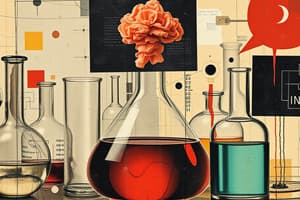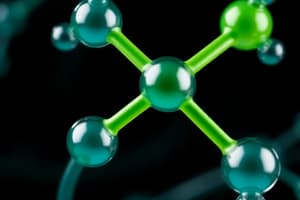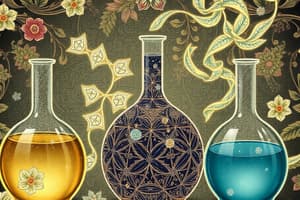Podcast
Questions and Answers
¿Qué describe mejor una solución?
¿Qué describe mejor una solución?
- Una combinación de varias sustancias en diferentes estados.
- Una mezcla heterogénea de soluto y solvente.
- Una mezcla homogénea de un soluto disuelto en un solvente. (correct)
- Una mezcla de sólidos que no interactúan entre sí.
¿Cuál es la función principal de la escala de pH?
¿Cuál es la función principal de la escala de pH?
- Registrar la temperatura de una reacción química.
- Medir la concentración de una solución.
- Medir la acidez o basicidad de una solución. (correct)
- Determinar la presencia de solutos en el solvente.
¿Qué concepto no está relacionado directamente con la termodinámica?
¿Qué concepto no está relacionado directamente con la termodinámica?
- Protones (correct)
- Energía libre
- Enthalpía
- Entropía
¿Cuál de las siguientes afirmaciones sobre ácidos y bases es correcta?
¿Cuál de las siguientes afirmaciones sobre ácidos y bases es correcta?
¿Qué indicate la presencia de un grupo funcional en un compuesto orgánico?
¿Qué indicate la presencia de un grupo funcional en un compuesto orgánico?
¿Cuál de las siguientes afirmaciones es verdadera sobre la materia?
¿Cuál de las siguientes afirmaciones es verdadera sobre la materia?
¿Qué tipo de propiedades de la materia se puede observar sin cambiar su composición?
¿Qué tipo de propiedades de la materia se puede observar sin cambiar su composición?
¿Cómo se organizan los elementos en la tabla periódica?
¿Cómo se organizan los elementos en la tabla periódica?
¿Cuál de los siguientes ejemplos representa una molécula?
¿Cuál de los siguientes ejemplos representa una molécula?
En una reacción química, ¿cuáles son los reactantes?
En una reacción química, ¿cuáles son los reactantes?
¿Qué describe correctamente la estequiometría?
¿Qué describe correctamente la estequiometría?
¿Cuál es la suma de protones y neutrones en un átomo?
¿Cuál es la suma de protones y neutrones en un átomo?
¿Cuál de las siguientes opciones describe a un compuesto?
¿Cuál de las siguientes opciones describe a un compuesto?
Flashcards
Química
Química
El estudio científico de la materia, sus propiedades y cambios.
Materia
Materia
Todo lo que ocupa espacio y tiene masa.
Estados de la materia
Estados de la materia
Los tres estados son sólido, líquido y gas.
Propiedades físicas
Propiedades físicas
Signup and view all the flashcards
Átomos
Átomos
Signup and view all the flashcards
Elementos
Elementos
Signup and view all the flashcards
Compuestos
Compuestos
Signup and view all the flashcards
Reacciones químicas
Reacciones químicas
Signup and view all the flashcards
Soluciones
Soluciones
Signup and view all the flashcards
Ácidos
Ácidos
Signup and view all the flashcards
Bases
Bases
Signup and view all the flashcards
Termodinámica
Termodinámica
Signup and view all the flashcards
Estructura Atómica
Estructura Atómica
Signup and view all the flashcards
Study Notes
Introduction to Chemistry
- Chemistry is the scientific study of matter, its properties, composition, and the changes it undergoes.
- It encompasses a vast range of phenomena, from the smallest subatomic particles to the largest astronomical structures.
- It is often divided into various branches, such as organic chemistry, inorganic chemistry, physical chemistry, and analytical chemistry.
Matter and its Properties
- Matter is anything that occupies space and has mass.
- Matter exists in three fundamental states: solids, liquids, and gases.
- Solids have a definite shape and volume.
- Liquids have a definite volume but no definite shape.
- Gases have neither a definite shape nor a definite volume.
- Properties of matter can be classified as physical or chemical.
- Physical properties can be observed and measured without changing the substance's composition, such as color, melting point, and density.
- Chemical properties describe how a substance reacts with other substances, resulting in a change in its composition, such as flammability and reactivity.
Atoms and Elements
- Atoms are the fundamental building blocks of matter.
- Elements are pure substances made up of only one type of atom.
- The periodic table organizes elements based on their atomic structure and properties.
- Each element is represented by a unique symbol, e.g., H for hydrogen, O for oxygen.
- Atomic number indicates the number of protons in an atom's nucleus.
- Atomic mass is the sum of protons and neutrons in an atom.
Molecules and Compounds
- Molecules are formed when two or more atoms bond together chemically.
- Compounds are formed when two or more different elements chemically combine in a fixed ratio.
- The chemical formula represents the composition of a molecule or compound.
- Examples of molecules: water (H₂O), carbon dioxide (CO₂).
- Examples of compounds: salt (NaCl), sugar (C₁₂H₂₂O₁₁).
Chemical Reactions
- Chemical reactions involve the rearrangement of atoms to form new substances.
- Reactants are the substances that undergo the change.
- Products are the substances formed after the reaction.
- Chemical equations represent the reaction using symbols for the reactants and products.
- Examples of chemical reactions: combustion, acid-base reactions, redox reactions.
Stoichiometry
- Stoichiometry deals with the quantitative relationships between reactants and products in a chemical reaction.
- It involves calculating the amounts of substances involved, such as moles, masses, and volumes.
- Based on balancing chemical equations.
Solutions
- Solutions are homogeneous mixtures composed of a solute and a solvent.
- The solute is the substance dissolved, and the solvent is the substance doing the dissolving.
- Solutions can exist in various states (e.g., solid, liquid, gas).
- Concentration is a measure of the amount of solute present in a given amount of solution.
Acids and Bases
- Acids are substances that donate protons (H⁺) in a chemical reaction.
- Bases are substances that accept protons (H⁺).
- The pH scale measures the acidity or basicity of a solution.
- A neutral solution has a pH of 7.
- Acids have a pH less than 7, and bases have a pH greater than 7.
Thermodynamics
- Thermodynamics studies the relationship between heat, work, and energy in chemical processes.
- Key concepts include enthalpy, entropy, and free energy.
- These concepts determine whether a reaction will occur spontaneously.
Organic Chemistry
- Focuses on the study of carbon compounds.
- Covers vast variety of molecules found in living organisms.
- Includes concepts like functional groups, isomers, and reactions.
Atomic Structure
- Atoms are composed of protons, neutrons, and electrons.
- Protons and neutrons are located in the nucleus.
- Electrons orbit the nucleus in specific energy levels.
Studying That Suits You
Use AI to generate personalized quizzes and flashcards to suit your learning preferences.




